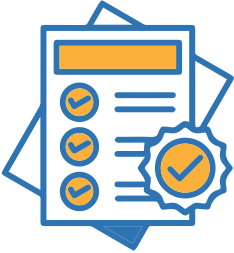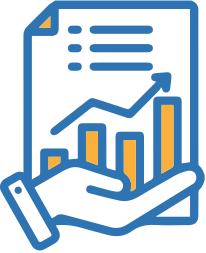Data Analytics Can Help Improve Sales And Marketing Strategies
Every business with an online presence has access to vast amounts of raw data. This data can come in the form of engagement with leads through your website or social media presence, feedback from your customers, information provided via your website forms, and by tracking customer engagement. It’s a lot of data, which means sifting through all of it, and finding meaning within it can be a severe challenge. Fortunately, you can make sense of your data through the use of data analytics.
Data analytics is the process of analyzing raw data and drawing conclusions based on the information gathered. Businesses make use of analytics tools, which are automated to sift through enormous amounts of data and to provide users with easy-to-understand metrics. By implementing various data analytics tools, you can obtain valuable insights that you can then leverage to make better, more informed decisions.
Why You Should Use Data Analytics
Analyzing the data you’ve collected from your prospects, leads, and customers can go a long way towards pinpointing what marketing and sales tactics are working. Being able to identify weaknesses in your strategies by looking at the data will allow you to make the proper adjustments and ensure that you’re not wasting resources on something that is not working.
Not only can the use of data analytics help guide your decision making to improve the results of your sales and marketing strategies, but they can help your marketing strategy become more cost-effective. Here are a few specific ways that your organization’s sales and marketing strategies could benefit from the use of data analytics:
Make More Informed Business Decisions
Through the use of dashboards and reporting, you can visualize the results generated by your data analytics tools and have access to data analytics in real-time. Real-time access to data will allow you to not only make more informed decisions but also to make those decisions faster and more accurately. Before real-time analytics were available, businesses were often forced to make decisions based on monthly reports, which quickly became outdated soon after they were published. Because we can generate data analytics in real-time, business leaders can be more confident in the decisions they make, and also help reduce the risk of making wrong decisions.
Improve The Customer Experience
Data analytics allows you to gain more insight into your target audience, helping to develop and refine buyer personas, which can help you create content that’s more relevant to your target audience. You can also use data analytics to personalize interactions with your prospects and customers as well. For example, you can use analytics to identify a customer’s purchase habits and website behavior to guide how you engage with them. Maybe that particular customer interacts more via social media than they do through email, and interacting with them on social media might be more effective.
Improve The Effectiveness Of Your Marketing Strategy
Using data analytics, you can gather a lot of information about the performance of various marketing tactics. For example, you can compare how different blog posts are performing by monitoring metrics like number of visitors, social shares, comments, earned links, click-through rates, and conversions. This kind of data can help you identify what’s working and what isn’t to make the proper adjustments. For instance, when comparing blog posts, you may recognize that a particular subject performs particularly well. You can then focus your content strategy more on that subject for better overall results.
Identify Ways To Reduce Operational Costs And Improve Efficiency
Leveraging data analytics can help to reduce your organization’s operational costs and improve efficiency in several ways. For example, using baselines, you can identify substantial indirect costs. Maybe your company is spending much more on energy costs than you realized. Using data analytics, you can determine if investing in certain upgrades could help save energy costs over the long run and whether the investment would be worth it. Data analytics can also help you identify ways to manage other organizational expenses, reduce turnover, and improve the efficiency of various processes.
Improve The Understanding Of Potential Risks
While you can’t measure risk precisely, you can use analytics to build measurement parameters to establish and examine risk scenarios. You’ll then be able to understand the potential effect of certain risks better and to plan for them appropriately. A better understanding of potential risks will allow you to mitigate potential security risks and fraud incidents.
Anticipate Customer Needs
Data analytics can be instrumental in anticipating the needs of your customers, which in turn can help you build the relationships you have with those customers. For example, if their purchasing history suggests that they buy a particular product every two months, you can send them a promotional offer that’s relevant to the product they generally buy before they make their next purchase. Anticipating customer needs can not only help improve sales in general; it can help you find cross-selling and upselling opportunities that will enhance the customer experience.
Optimize Your Pricing Strategy
Data analytics can help you identify the products and services that sell the best, which audience segments are the most or the least profitable, how much revenue a product or service needs to generate to make a profit, and more. All of this data can be applied to help you optimize the pricing of your products and services to produce the most potential revenue and profits possible.
Understanding Your Data
There are two main types of data that you can analyze: structured data and unstructured data. The way that your data is structured determines how it is collected and processed and how insights can be extracted.
Structured Data
Data that is structured is often referred to as quantitative data. Structured data can be easily searched in relational databases, such as tables and spreadsheets. It can include data such as email addresses, names, dates, transactional information, identification numbers, and more. Because structured data is already somewhat organized by nature, it’s easier to analyze.
Unstructured Data
Most raw data is unstructured. Estimates are that between 80 and 90 percent of the raw data, a typical organization has access to, is unstructured. Unstructured data can include social media posts, audio files, video files, email messages, word processing documents, business documents, and more. To be able to collect, organize, and analyze unstructured data, you must utilize data lakes or NoSQL databases.
Types Of Data Analytics
There are different reasons to analyze the data that you have. For example, you might be trying to identify an issue, look for a pattern, or predict a trend that will help guide your marketing or sales efforts. That’s why there are four different types of data analytics that you can implement depending on the results that you are seeking. These types of data analytics include the following:
Descriptive Analytics
Descriptive analytics is the most common form of analytics. It helps describe what happened over a specific time period. For example, identifying whether sales have increased over one month is a form of descriptive analytics.
Diagnostic Analytics
Diagnostic analytics focuses on why something happened and does require some hypothesizing—for instance, using data to hypothesize that sales increased over one month due to a new product release.
Predictive Analytics
Predictive analytics allows you to use data to forecast what is going to happen in the future. For example, if the data shows that sales have spiked during the winter each of the last three years, then you could predict that sales will also increase in the upcoming winter.
Prescriptive Analytics
Prescriptive analytics is about using the data you have to determine the action you should take. For example, if predictive analytics showed that you’re likely to experience a spike in sales during the upcoming winter, then using other analytics to determine what kind of actions will result in the best outcomes. Such as increasing stock of products available during the winter or taking on more employees to handle additional sales.
5 Steps Of The Data Analysis Process
To leverage data analytics in a way that will improve your decision making and to drive real results as far as your marketing and sales strategies are concerned, you will need to follow a step-by-step process. Effectively implementing data analytics can be done if you follow these five steps:
Establish A Goal
Start by defining what your goals are. For example, you may want to determine why sales are dropping and what you can do to turn things around. Without goals, you likely won’t obtain any actionable insights.
Implement A Means Of Collecting Data
Data can be collected both internally and externally. Implementing a CRM solution or an ERP system can help you gather and organize structured data from all of your internal data sources. Collecting external data can be done by accessing any open data sources, such as industry-specific finance or economic datasets, that are available to your organization.
Clean Data
Once you’ve implemented a way to collect data, you will need to clean the data you’ve collected. Cleaning data involves deleting duplicate data, eliminating obsolete data, correcting errors, updating outdated information, and filling out incomplete data.
Analyze Data
Once your data is determined to be clean, there are a variety of ways that you can analyze your data. For example, you can implement data mining techniques to perform a more thorough analysis. You can also simply implement a business intelligence solution that will generate user-friendly charts and reports based on the KPIs (key performance indicators) that you’ve established.
Interpret Results
After analyzing the data, it’s up to you to interpret the results and make the appropriate decisions and actions based on your interpretation of those results. It’s one of the reasons why establishing your goals from the outset is so important.
Implementing A Data Governance Strategy
Regularly cleaning your data can help ensure its accuracy, cleaning data can be a time-consuming process, and one that you probably don’t have enough resources to do daily. A best practice is to prevent your data from being inaccurate in the first place. A data governance strategy will do just that.
Keep in mind that data governance is much more than just ensuring that your data is accurate. It’s a series of protocols that will help manage the usability, integrity, availability, and security of your data. We list below the reasons why a data governance strategy is so important:
Prevent Data Silos
By not correctly integrating data sources, data silos will occur. Data silos can result in your data analytics being inaccurate and incomplete. All of your data needs to be aggregated from every data source to ensure the effectiveness of your analytics.
Improve Data Quality
Effective analytics depends entirely on the quality of your data. If your data is poor, to begin with, then your analytics will be as well. Improving data quality requires that you standardize data entry and that you clean your data regularly by removing or replacing incomplete, incorrect, or obsolete data.
Improve Accountability
Besides making sure that everyone responsible for data entry abides by specific security protocols and entry standardizations, you may also want to assign permissions. Permissions improve accountability throughout your organization by making it easier to determine who is responsible for what data.
Ensure Regulatory Compliance
Depending on your industry, there are various regulations that you will be required to comply with regarding the security of your data. These regulations are in place for the privacy and security of the customers and prospects whose data you’re collecting. If you’re collecting data, then data governance is vital to protecting that data. You may be collecting sensitive information, such as names, emails, addresses, phone numbers, and credit card numbers, which can be used to commit fraud if stolen.
Use Data Analytics To Improve Your Organization Across The Board
Using data analytics allows you to take advantage of the massive amounts of data available from prospects, leads, and customers. Successfully leveraging data analytics can help you make better decisions, identify problem areas that needing attention, identify patterns and trends, and predict success. All of which can help you to implement a more effective and efficient marketing and sales strategy.















